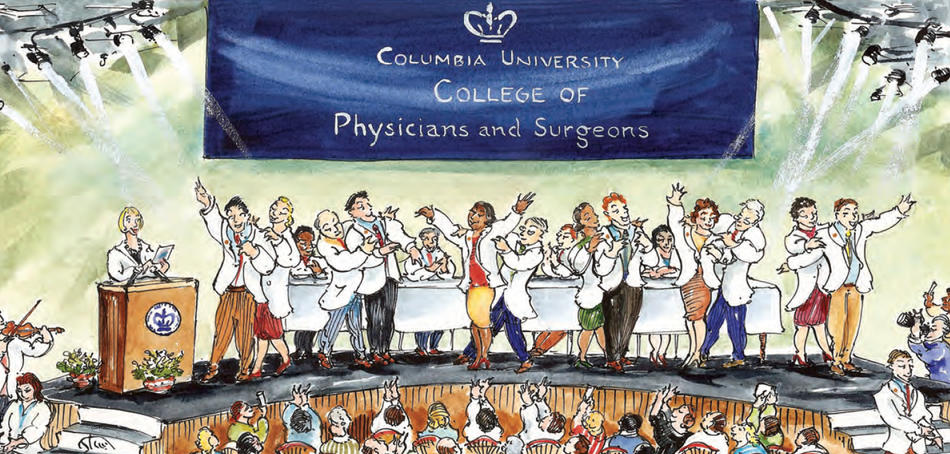Just after 4:30 on a pleasant August afternoon, 160 young men and women — many of them smiling, a fair number of them solemn — filed into the Physicians and Surgeons Alumni Auditorium on West 168th Street. The hall was packed to standing room and filled with the classical strains of piano and violin, played by members of the P&S Musicians’ Guild. The audience buzzed, struck by the signal aspect of the procession: each marcher bore, across his or her forearm, a white laboratory coat.
After an invocation from University chaplain Jewelnel Davis and speeches from faculty members, the coat carriers were called to the podium by name in groups of six. They handed their coats to half a dozen “cloakers,” all physicians, who then helped them slip on the garments. When all had been enrobed and resumed their seats, Lisa Mellman ’91PS, the senior associate dean for student affairs at P&S, bade them stand again as she introduced them en masse to the crowd of relatives and friends: “I present to you the Class of 2018.”
The applause was considerable.
It was the University’s twenty-second white-coat ceremony, celebrating the initiation of a new class of future physicians. Established at P&S in 1993, the tradition has since spread to 96 percent of the accredited medical schools in the US as well as to schools in more than a dozen other countries.
For many of the initiates, the rite of passage was a revelation. “I had no idea it was that big a deal until I got here,” said Fatimah Alkhunaizi at the reception afterward. She had arrived at P&S after a childhood spent in Indianapolis, high school in Saudi Arabia, and college at Johns Hopkins. “I was crying on the stage. I’m still a little teary.” Alissa Rogol, a Princeton graduate who first learned about the ceremony from her childhood best friend, insisted that she had not tried on her white coat in advance of the proceedings: “That would have been seven years’ bad luck.”
White coats have been synonymous with MDs for about a century. Their popularity took off after a 1910 report by Abraham Flexner revolutionized the profession by urging clinical training and laboratory experience. As physicians became more closely aligned with scientists, they adopted their uniform. At first, their coats were generally beige. But white, with its associations with purity and health, soon became the norm.
The white-coat ceremony was devised by Arnold P. Gold, a Columbia professor of clinical neurology and clinical pediatrics. When he formed his namesake foundation in 1988, he did so in large part to improve the doctor–patient relationship. Now, seated in a wheelchair at the speakers’ table, he told the assembled that back when he was a medical student, his dean gave him only one requirement — to wear a white coat. That sartorial directive became shorthand for a philosophy.
“As you are cloaked in your first white coat, and make a psychological contract about the kind of doctor you want to become, we hope you will notice a gift from our foundation — a pin bearing our logo — on which the words ‘Humanism in Medicine’ are inscribed,” he told the students. “We encourage you to wear this pin as a daily reminder of today’s ceremony and of the awesome pledge you are about to make.”
The event has always included a keynote address; in 1997 the New Yorker contributor Jerome Groopman ’72CC, ’76PS did the honors (he was in the audience this time around to see his daughter Emily get her white coat). This year, the nod went to associate professor of neurology Olajide Williams ’04PH. And for the first time, thanks to Sheldon Feldman, an associate professor of clinical surgery, the lecture was endowed. It is now named for Feldman’s sister, Fern Feldman Anolick, who died of breast cancer at thirty-seven in 1979, leaving three children.
“She had the best doctors, technically speaking,” Feldman said from the dais. “But they weren’t necessarily the best human beings, and some of their words are still hurtful.” Later, Feldman recalled that when Fern began to develop symptoms, he took his family to the hospital where he had been a resident, so Fern could be diagnosed by one of his mentors. His parents asked for a prognosis. “He literally said to them, ‘If I were your daughter, I would jump out the window.’”
Feldman paused. “Had he just hugged my mother and said, ‘We’re going to do what we can,’ it would have been kind and reassuring. But he didn’t. Even when we can’t cure patients, we can still be healers with compassion.”
The white-coat ceremony concluded with Mellman administering the Hippocratic oath, imploring her charges to exercise their art “in uprightness and honor,” and solely for the benefit of their patients. Robert Kelly, president of New York–Presbyterian Hospital, offered some closing remarks.
“Those white coats that you put on just now felt a little clunky,” Kelly said. “They felt a little big. But you will grow into them in the next four years.”



